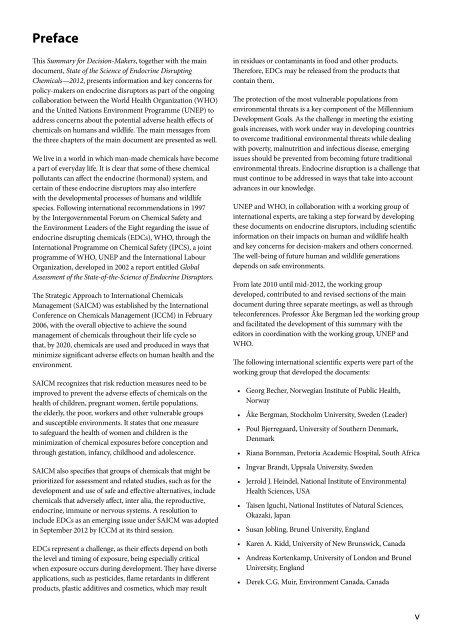Endocrine Disrupting Chemicals 2012 - World Health Organization
Endocrine Disrupting Chemicals 2012 - World Health Organization
Endocrine Disrupting Chemicals 2012 - World Health Organization
Create successful ePaper yourself
Turn your PDF publications into a flip-book with our unique Google optimized e-Paper software.
Preface<br />
This Summary for Decision-Makers, together with the main<br />
document, State of the Science of <strong>Endocrine</strong> <strong>Disrupting</strong><br />
<strong>Chemicals</strong>—<strong>2012</strong>, presents information and key concerns for<br />
policy-makers on endocrine disruptors as part of the ongoing<br />
collaboration between the <strong>World</strong> <strong>Health</strong> <strong>Organization</strong> (WHO)<br />
and the United Nations Environment Programme (UNEP) to<br />
address concerns about the potential adverse health effects of<br />
chemicals on humans and wildlife. The main messages from<br />
the three chapters of the main document are presented as well.<br />
We live in a world in which man-made chemicals have become<br />
a part of everyday life. It is clear that some of these chemical<br />
pollutants can affect the endocrine (hormonal) system, and<br />
certain of these endocrine disruptors may also interfere<br />
with the developmental processes of humans and wildlife<br />
species. Following international recommendations in 1997<br />
by the Intergovernmental Forum on Chemical Safety and<br />
the Environment Leaders of the Eight regarding the issue of<br />
endocrine disrupting chemicals (EDCs), WHO, through the<br />
International Programme on Chemical Safety (IPCS), a joint<br />
programme of WHO, UNEP and the International Labour<br />
<strong>Organization</strong>, developed in 2002 a report entitled Global<br />
Assessment of the State-of-the-Science of <strong>Endocrine</strong> Disruptors.<br />
The Strategic Approach to International <strong>Chemicals</strong><br />
Management (SAICM) was established by the International<br />
Conference on <strong>Chemicals</strong> Management (ICCM) in February<br />
2006, with the overall objective to achieve the sound<br />
management of chemicals throughout their life cycle so<br />
that, by 2020, chemicals are used and produced in ways that<br />
minimize significant adverse effects on human health and the<br />
environment.<br />
SAICM recognizes that risk reduction measures need to be<br />
improved to prevent the adverse effects of chemicals on the<br />
health of children, pregnant women, fertile populations,<br />
the elderly, the poor, workers and other vulnerable groups<br />
and susceptible environments. It states that one measure<br />
to safeguard the health of women and children is the<br />
minimization of chemical exposures before conception and<br />
through gestation, infancy, childhood and adolescence.<br />
SAICM also specifies that groups of chemicals that might be<br />
prioritized for assessment and related studies, such as for the<br />
development and use of safe and effective alternatives, include<br />
chemicals that adversely affect, inter alia, the reproductive,<br />
endocrine, immune or nervous systems. A resolution to<br />
include EDCs as an emerging issue under SAICM was adopted<br />
in September <strong>2012</strong> by ICCM at its third session.<br />
EDCs represent a challenge, as their effects depend on both<br />
the level and timing of exposure, being especially critical<br />
when exposure occurs during development. They have diverse<br />
applications, such as pesticides, flame retardants in different<br />
products, plastic additives and cosmetics, which may result<br />
in residues or contaminants in food and other products.<br />
Therefore, EDCs may be released from the products that<br />
contain them.<br />
The protection of the most vulnerable populations from<br />
environmental threats is a key component of the Millennium<br />
Development Goals. As the challenge in meeting the existing<br />
goals increases, with work under way in developing countries<br />
to overcome traditional environmental threats while dealing<br />
with poverty, malnutrition and infectious disease, emerging<br />
issues should be prevented from becoming future traditional<br />
environmental threats. <strong>Endocrine</strong> disruption is a challenge that<br />
must continue to be addressed in ways that take into account<br />
advances in our knowledge.<br />
UNEP and WHO, in collaboration with a working group of<br />
international experts, are taking a step forward by developing<br />
these documents on endocrine disruptors, including scientific<br />
information on their impacts on human and wildlife health<br />
and key concerns for decision-makers and others concerned.<br />
The well-being of future human and wildlife generations<br />
depends on safe environments.<br />
From late 2010 until mid-<strong>2012</strong>, the working group<br />
developed, contributed to and revised sections of the main<br />
document during three separate meetings, as well as through<br />
teleconferences. Professor Åke Bergman led the working group<br />
and facilitated the development of this summary with the<br />
editors in coordination with the working group, UNEP and<br />
WHO.<br />
The following international scientific experts were part of the<br />
working group that developed the documents:<br />
• Georg Becher, Norwegian Institute of Public <strong>Health</strong>,<br />
Norway<br />
• Åke Bergman, Stockholm University, Sweden (Leader)<br />
• Poul Bjerregaard, University of Southern Denmark,<br />
Denmark<br />
• Riana Bornman, Pretoria Academic Hospital, South Africa<br />
• Ingvar Brandt, Uppsala University, Sweden<br />
• Jerrold J. Heindel, National Institute of Environmental<br />
<strong>Health</strong> Sciences, USA<br />
• Taisen Iguchi, National Institutes of Natural Sciences,<br />
Okazaki, Japan<br />
• Susan Jobling, Brunel University, England<br />
• Karen A. Kidd, University of New Brunswick, Canada<br />
• Andreas Kortenkamp, University of London and Brunel<br />
University, England<br />
• Derek C.G. Muir, Environment Canada, Canada<br />
v
















